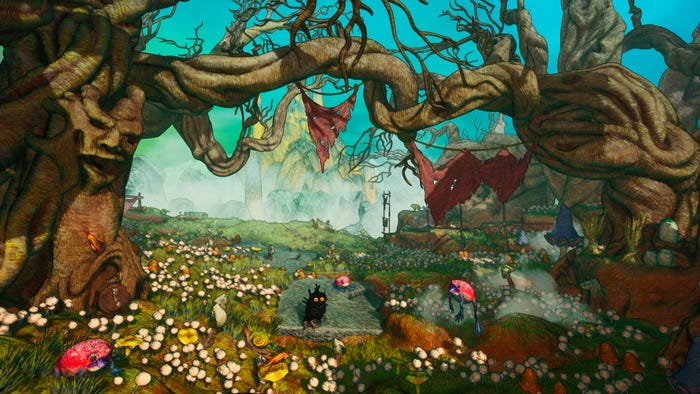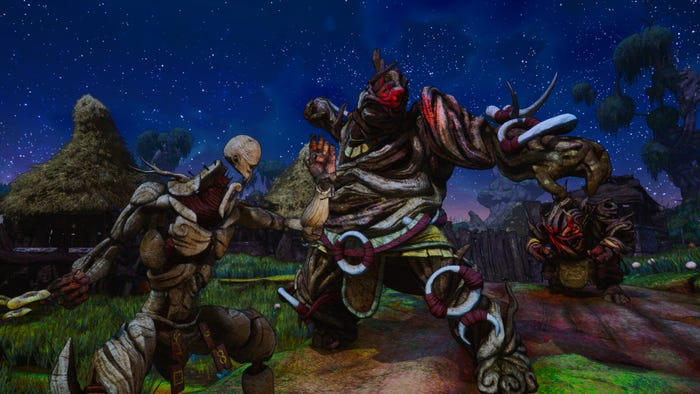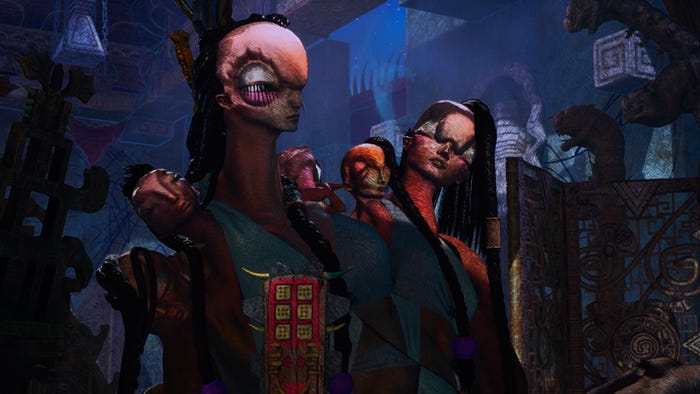Trending
Opinion: How will Project 2025 impact game developers?
The Heritage Foundation's manifesto for the possible next administration could do great harm to many, including large portions of the game development community.

Andres Bordeu of ACE Team talks about finding unique artistic inspirations and feeling out the look of their compelling protagonists in Clash: Artifacts of Chaos.

The IGF (Independent Games Festival) aims to encourage innovation in game development and to recognize independent game developers advancing the medium. Every year, Game Developer sits down with the finalists for the IGF ahead of GDC to explore the themes, design decisions, and tools behind each entry. Game Developer and GDC are sibling organizations under Informa Tech
Clash: Artifacts of Chaos guides a reclusive martial artist across a dangerous world, swapping between fighting styles (and sometimes playing a game of dice) as they explore this strange natural place.
Game Developer caught up with Andres Bordeu of ACE Team, developers of the Excellence in Visual Art-nominated title, to talk about how past games they’d developed would help shape this new game’s combat systems, the importance of looking for different inspirations when creating enemies and places to create a gameplay experience that stands out, and how they created a striking protagonist for the game by finding a design that “spoke to them.”
Who are you, and what was your role in developing Clash: Artifacts of Chaos?
Hello, my name is Andres Bordeu and I was one of the lead designers / directors on Clash: Artifacts of Chaos.
What's your background in making games?
I’m one of the cofounders of ACE Team, an award-winning indie studio from Chile that has developed some of the most recognizable IPs from the region. We’ve been developing games for over 15 years now on all major platforms.

Images via ACE Team
How did you come up with the concept for Clash: Artifacts of Chaos?
Clash: Artifacts of Chaos is a prequel to our debut game; Zeno Clash. We had always wanted to return to this universe, but we knew that it would require a big effort to develop a noteworthy addition to the saga after having developed Zeno Clash 2, which was, at the time, the most ambitious project we had developed. It took us many years before we decided it was time to make another game, because developing a world of a similar scope was a big undertaking for our team.
What development tools were used to build your game?
This game was developed in Unreal Engine 4.
What thoughts went into designing the combat system for Clash: Artifacts of Chaos? What drew you to change it from the first-person perspective of the previous Zeno Clash games?
Zeno Clash was well known for its first person melee combat, which was a novelty when we presented it. In this game we wanted to develop an entirely new system, and we wanted to explore combat in a third person perspective. We knew this was a bold move because many fans of the first two games would expect a first person camera again, but because we wanted players to create a strong relationship with the protagonists we needed them to be on-camera. Fortunately, the change was very well received. We also left a little of first person combat in the form of special moves—something that players of the previous games surely appreciated.
What sort of research went into creating the fighting styles? Can you tell us a bit about what you looked into to help craft the combat system?
We looked at some other prominent third person action/adventure titles. I think God of War and Dark Souls were the ones we referenced the most, but we also went back and explored concepts we had already developed in older titles. Specifically, we looked at Abyss Odyssey, which is a 2D platform action/adventure game with a robust combat system we made back in 2014. All the combo “canceling” mechanics were derived from that game.

Images via ACE Team
What challenges did you face in teaching players how to work with so many different styles and possibilities?
I think the hardest thing was to make sure that all combat stances remained a valid choice for players that wanted to explore different strategies. For a long time, we had combat stances that were clearly overpowered and other ones that were useless. We first saw this when our QA team always gravitated to the same moves.
Making combat games is harder than it seems. It only takes a small variation of a given stat to make a move too effective, and players will always find these exploits. And, if these exploits exist, the game becomes repetitive. Fortunately, we were able to calibrate everything properly, and a testament to this is seeing that there is a great variety of preferences among players from our community when choosing their preferred combat style.
What thoughts go into designing challenging encounters that will push players to be creative with all of these powers? What ideas go into making a satisfying fight in Clash: Artifacts of Chaos?
We viewed the dice game (The Ritual) as a canvas which players could use to approach combat with different strategies. Many action games require players to defeat enemies by exclusively learning their attack patterns and timing counter attacks. You can also do this in Clash: Artifacts of Chaos, but just like in Souls-like games, you can also bring special items or tools to tilt the odds in your favor, and the right tools can be as effective as mastering the combat system. This is where The Ritual comes into play.
What thoughts went into this dice game? Into the benefits and downsides players could encounter?
The Ritual, a gameplay mechanic where players take turns to roll dice and place tokens to change the setup of the fight that succeeds, required us to carefully calibrate the system so it was intuitive and fun to play. We had to present it gradually. The first time you play it is the only time you are not playing Pseudo, because we didn’t want players to feel pressured if they lost while learning the ropes. We wanted to bring something fresh to the game that allowed players to explore different avenues when fighting enemies.
What thoughts went into creating the varied, creative creatures players will battle across the game? What ideas went into forming these strange beasts and opponents?
Clash: Artifacts of Chaos is inspired by the same things that inspired us when making Zeno Clash. The punk fantasy themes allowed us to explore other-wordly designs not constrained by the typical references you see in many of today’s pop culture media. Instead of looking at medieval fantasy references of Hollywood, we could look at surreal paintings, fantasy illustrations of the 80’s, etc. John Blanche’s illustrations and Heriounymus Bosch paintings are some of the many references we took into account when making all three games.

Images via ACE Team
Clash: Artifacts of Chaos lets players explore a vibrant world that hints at lost histories. what thoughts went into designing the world, visually, to create this sense of a buried past and forgotten stories?
Fortunately, we did a lot of world building when we developed the first two games, so the game’s mythos are abundant and you can sense there’s a larger universe from where this story plays out. The themes are always the same: stories about family, origins, and how it embraces these strange creatures. Despite all the alien presentation, the core premise had to be around themes that people could relate to. A story about friendship, loss, and parenthood would hit harder in our view than a fantasy trope of the hero conquering evil and saving the world.
Can you tell us about the design process for Pseudo? How did you design this unique protagonist, and how did their design change over the course of development?
Many of our design choices in these games have been a bit unorthodox, so it couldn’t be any different when choosing our protagonist. I mentioned “choosing” instead of “designing,” because unlike what you’d expect from a typical pre-production process, where the hero is extensively developed by molding his appearance through a long iterative process, we instead looked at many old rough concepts of characters (designs that stemmed from different silhouettes or lines) and chose the ones that spoke to us. Pseudo’s rough concept spoke to us more than any other design, almost as if he was meant to play the part. When we developed the first game, the process through which we chose the antagonist was very similar.
Can you also tell us about how you designed the Boy, visually?
The design process for the boy was a bit more conventional. We needed him to be a strong match with the protagonist, and he needed to feel naive, lovable, and fragile. Some of Studio Ghibli’s characters were used as a reference when designing him. The voice-talent behind both characters was also critical to their character, because the performance needed to enhance their appearance and make them believable.
The Clash games all clearly show a focus on striking visual styles. What thoughts go into creating a style that will capture the imagination of the player? What thoughts go into taking players to some place new and unique, visually?
I think that whenever you create content about things that you are passionate about, it always shows in the final work. We were passionate about the art style, about the story, about the music, and everything else that is portrayed in the game. And we know that players felt this because we’ve seen so many wonderful messages from our community telling us what the game meant to them. In the end, I think this is more important than anything else because passion can be the most important driver in creating something unique.
You May Also Like